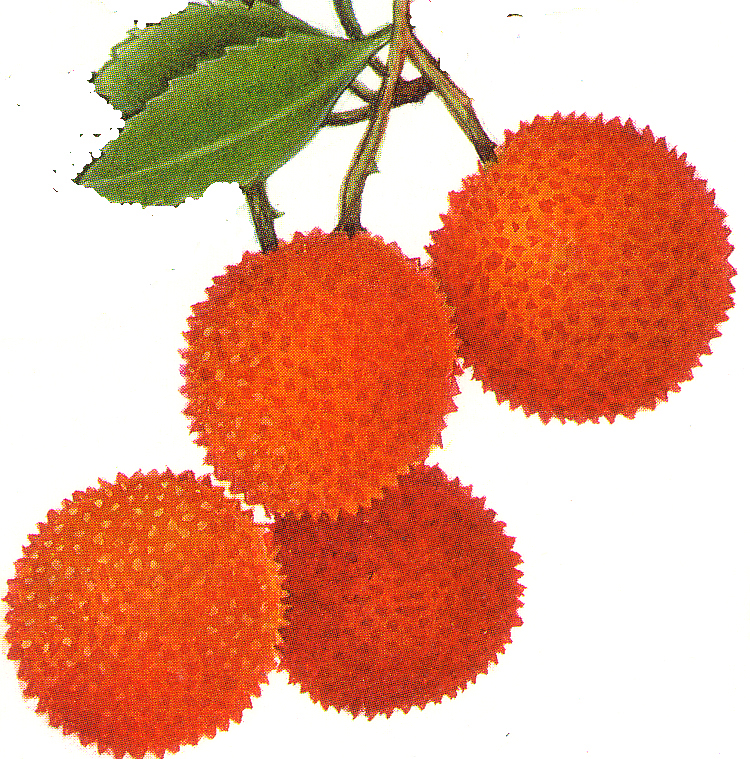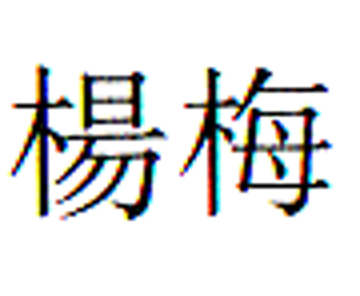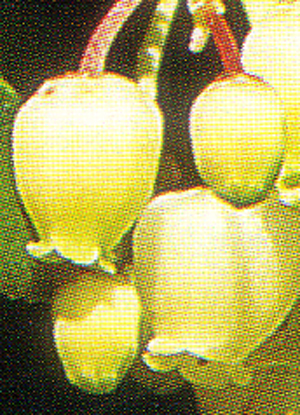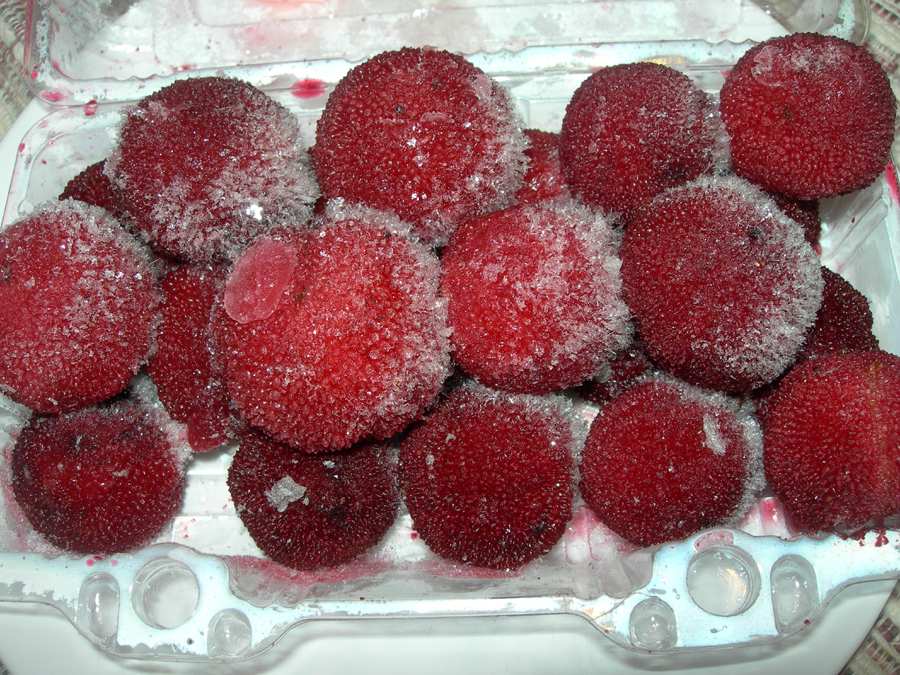
| What is Flavor and Fortune? |
| How do I subscribe? |
| How do I get past issues? |
| How do I advertise? |
| How do I contact the editor? |
Read 12958174 times
Connect me to:
| Home |
| Articles |
| Book reviews |
| Letters to the Editor |
| Newmans News and Notes |
| Recipes |
| Restaurant reviews |
| Article Index (all years, slow) |
| List of Article Years |
| Article Index (2025) |
| Article Index (last 2 years) |
| Things others say |
| Related Links |
| Log In... |
| Authors |
| Categories & Topics |
Arbutus: The Strawberry Tree
| by Jacqueline M. Newman |
Fruits, Desserts, and Other Sweet Foods
Summer Volume: 2008 Issue: 15(2) page(s): 14 and 15

 Many berries confuse viewers by their looks and by their botanical and common names. The fruit of the arbutus is no exception. Related to the cranberry, often cultivated as an ornamental, and from a tree called the 'strawberry tree,' this fruit and several of its cultivars bear fruits of different colors. Most have lovely white flowers and shiny leaves, and those from this tree have tooth-like edges. The fruit is about the size of a strawberry and hence the tree’s nickname. The taste is bland, though slightly acidic, and therefore, quite refreshing.
Many berries confuse viewers by their looks and by their botanical and common names. The fruit of the arbutus is no exception. Related to the cranberry, often cultivated as an ornamental, and from a tree called the 'strawberry tree,' this fruit and several of its cultivars bear fruits of different colors. Most have lovely white flowers and shiny leaves, and those from this tree have tooth-like edges. The fruit is about the size of a strawberry and hence the tree’s nickname. The taste is bland, though slightly acidic, and therefore, quite refreshing.
 The Chinese variety of this fruit also known as a 'wax myrtle' can be from an evergreen shrub or low tree. Some do grow tall and are recorded at fifty feet. Botanically all of them are known as Myrica rubra. They originated in east-central China in the northern hilly areas in and around Zhejiang. This Chinese variety, some say, is not an arbutus. However, it and true arbutus bear fruit with warty exteriors and round or ovoid-shaped fruit, and both like cold or temperate climate with wet winters and hot dry summers. Newer cultivars of the Chinese variety can now be found in Guangdong and eastern China. They are also now found in Taiwan, Korea, and Japan. Some are wild but most are planted, and almost all of them are productive.
The Chinese variety of this fruit also known as a 'wax myrtle' can be from an evergreen shrub or low tree. Some do grow tall and are recorded at fifty feet. Botanically all of them are known as Myrica rubra. They originated in east-central China in the northern hilly areas in and around Zhejiang. This Chinese variety, some say, is not an arbutus. However, it and true arbutus bear fruit with warty exteriors and round or ovoid-shaped fruit, and both like cold or temperate climate with wet winters and hot dry summers. Newer cultivars of the Chinese variety can now be found in Guangdong and eastern China. They are also now found in Taiwan, Korea, and Japan. Some are wild but most are planted, and almost all of them are productive.
This Chinese wax myrtle is not new to China. Remains of it were found in a Han tomb in the Hunan Province. They were radio-carbon dated circa the second century BCE. An early written Chinese report said this fruit was known in the fourth century CE, but it did not advise if it was wild or cultivated. The Chinese call the fruit yang mei and several people have told us it is mentioned in the Zhou Li and in the Shang Lin Fu.
Most yang mei are deep red, but they can be white, orange, even purple. Markets carry them fresh, frozen, and canned, and in jams, jellies, and preserves. Manufacturers also use them to flavor wines, candies, cold drinks, and liqueurs.
Many summers back in Shanghai, we bought some fresh. That was our first exposure to them and we could find no one who could tell us their English name. They did tell us some medicinal uses, including that this fruit is valuable as a diuretic and great to consume when one suffers from a urinary infection. They also mentioned its tree bark as the item to use when tanning leather. When we got home and checked it out, we learned that the tannins in the bark make up about half of its content.
During the Sung Dynasty, these fruits were preserved in sugar. Before that, they were put up in honey. The same was true of other foods including arrowroot, quince, green apricots, and plums, both plain and peppered. Arbutus should be dried before preserving, and years ago this was done in the sun. After drying, they can be stored for months and used in any number of ways. Finding them dried in China may be easy, but we have never seen them that way in the United States. If you do, please tell us where to locate them.
Arbutus was thought indigenous to southern Europe, but the European variety is Arbutus unedo. North America has a related cultivar, Arbutus menziesii. It is commonly known as 'madrono' and it and Arbutus unedo are commonly said to be from the Killarney strawberry tree.
The fruits of all Arbutus cultivars take about a year to ripen. Most often, they are harvested by hand. One report said none of them should be eaten raw. The Chinese would strongly disagree and we would, too, as we have eaten them raw and are unsure why this admonition. Maybe it is because there are so many varieties, colors, and stories about them. For instance, there is considerable confusion about these fruits because arbutus trees and their fruit belong to the Ericaceae family while the tree strawberry of China is both a wax myrtle and a member of the Myricaceae family. This yang mei has long been known for its somewhat sour taste, and is part of a very famous Chinese idiom: yang mei zhi ke. A common translation is: 'to thirst stopped by looking at mei, the mouth waters when looking at the sour fruit.' That is confusing, too.
 Yang mei is now found in many ways. A grandson who knew I planned to write an article about this fruit found some in the frozen food section of a favorite Chinese supermarket. Seeing it frozen was a first for us. We have seen it in cans, found it in individual juice boxes wrapped six to a set, and purchased it fresh in China. We have never seen them fresh in the United States, though we do know they grow here. Exactly where, we have yet to learn, perhaps one of our readers can help on that score.
Yang mei is now found in many ways. A grandson who knew I planned to write an article about this fruit found some in the frozen food section of a favorite Chinese supermarket. Seeing it frozen was a first for us. We have seen it in cans, found it in individual juice boxes wrapped six to a set, and purchased it fresh in China. We have never seen them fresh in the United States, though we do know they grow here. Exactly where, we have yet to learn, perhaps one of our readers can help on that score.
Rare is the recipe that cooks this fruit, though there are a few. We made the ones below with dark reddish purple frozen fruit. Everyone who ate them loved their looks, color, and their taste. They were impressed that they are high in vitamin C and two tasters, both Chinese, said they like them in sherbets, sauces, and beverages. One reported the taste as similar to cider but better. For this article, we found none in a wine or a more potent beverage; but did get lots of positive feedback from the folks who consumed them as a fruit shake.
| Stuffed Pear with Arbutus |
|---|
4 Asian pears, tops cut off, cores removed 1 cup arbutus, each fruit cut in half 1/4 cup olive or pine nuts, toasted in dry fry pan 1/2 cup rock sugar, small white crystals Preparation: 1. Put pears in individual heat-proof Chinese soup bowls. 2. Divide yang mei evenly and put one-quarter into each pear cavity. 3. Mix nuts and rock sugar, and divide that evenly into each pear cavity; then put the bowls into a steamer over boiling water for half an hour. 4. Then reduce heat so that water barely simmers, and steam for another hour; then remove the bowls and serve one bowl to each person. |
| Arbutus and Silk Squash |
|---|
1/2 cup frozen arbutus 1 silk squash, peeled and angle cut into two-inch sections 10 large shrimp, peeled, their veins removed, cut in half the long way 5 medium black mushrooms, soaked, stems removed, and each cut in quarters 1 Tablespoon vegetable oil 1 clove garlic, peeled and slivered 1 slice fresh ginger, slivered 1 Tablespoon oyster sauce 1 teaspoon cornstarch Preparation: 1. Mash yang mei and set aside in a strainer basket over a small bowl. 2. Mix silk squash, shrimp, and mushrooms. 3. Heat wok or fry pan, add oil, garlic, and ginger and stir-fry for one minute. Remove garlic and ginger, and discard them. 4. Stir-fry the mixed vegetables and shrimp for two minutes, or until the shrimp turn pink. Remove them to a bowl. 5. Put oyster sauce into the wok, and heat to the boil. Mix cornstarch and the yang mei fruit, and add this to the wok with the set aside vegetables and shrimp. Allow to boil for one minute, put into a bowl, and serve. |
| No-strawberry Shake |
|---|
2 very ripe bananas, peel discarded, fruit mashed 1 cup frozen arbutus (the strawberry tree fruit) 2 Tablespoons sugar 1/2 teaspoon ground cardamon Preparation: 1. Put all ingredients and one-quarter of a cup of crushed ice into a blender. Turn on and off several times until ices partially crushed, then turn on and leave on for one minute. 2. When blended, pour into four glasses, and serve. |

Copyright © 1994-2025 by ISACC, all rights reserved
Address
3 Jefferson Ferry Drive
S. Setauket NY 11720